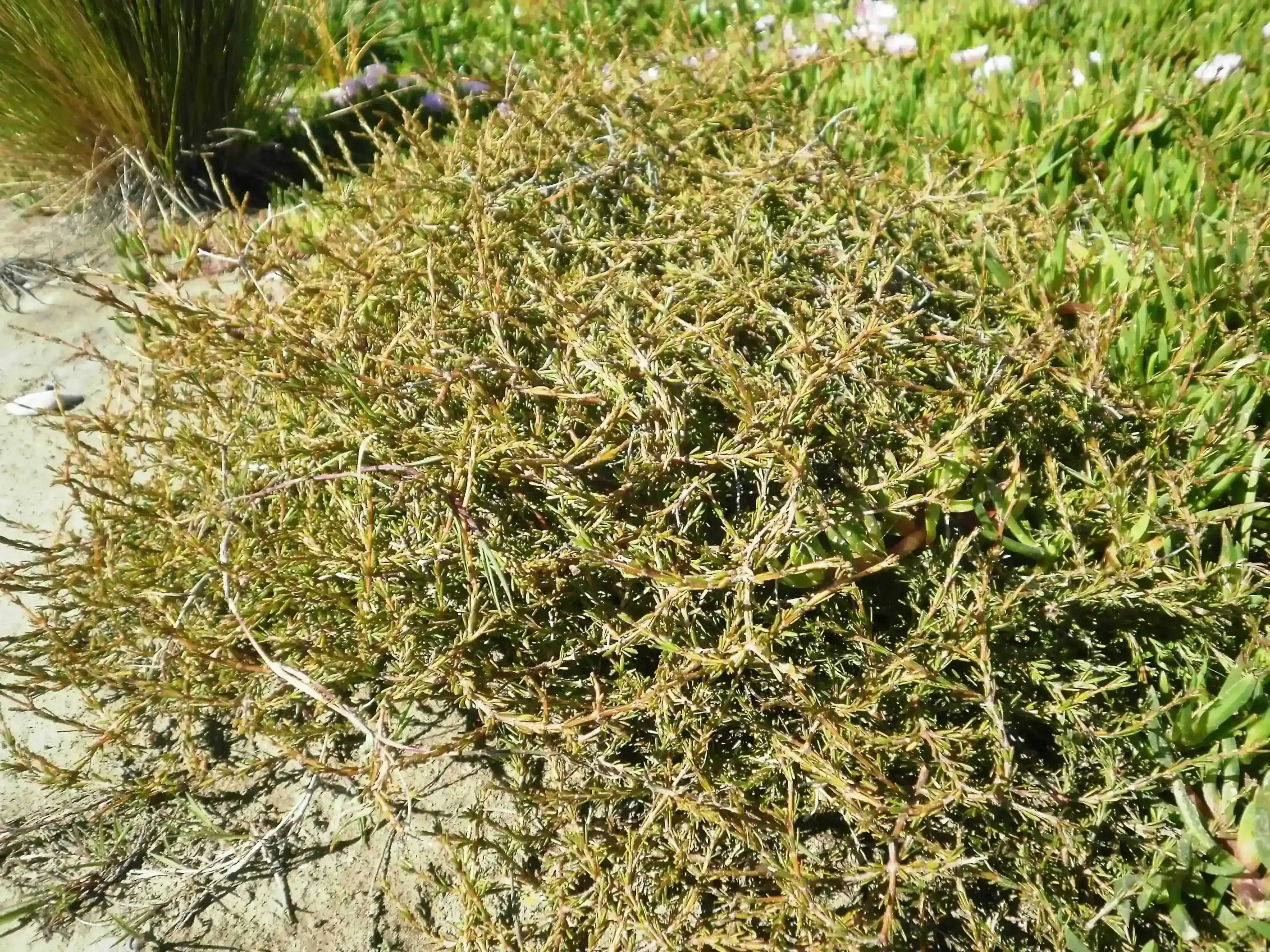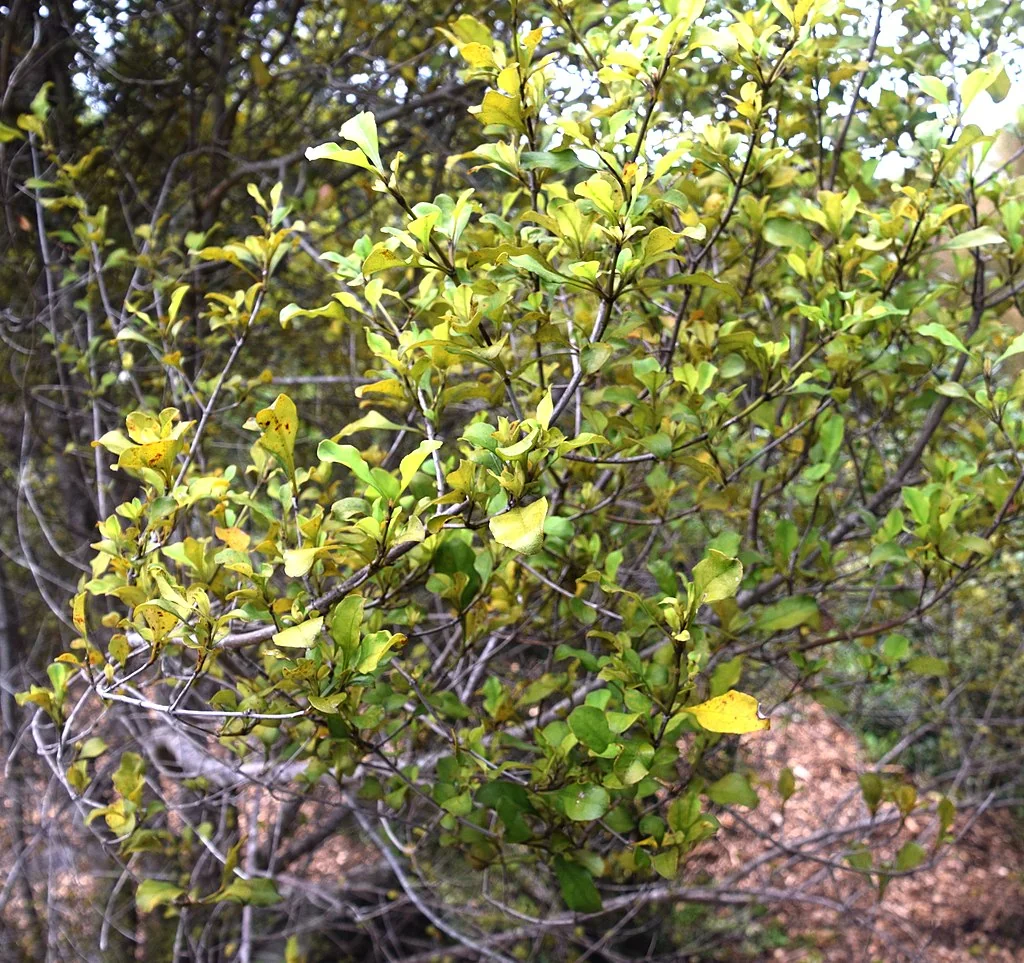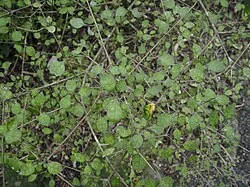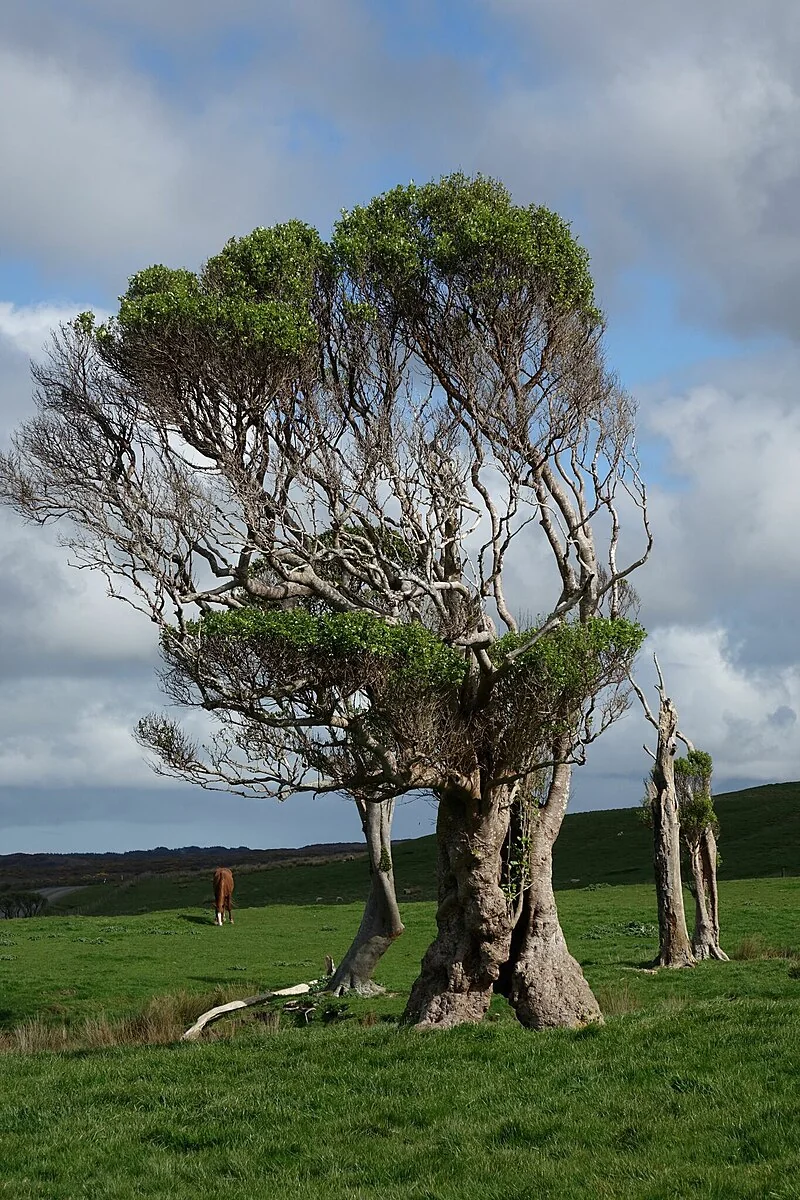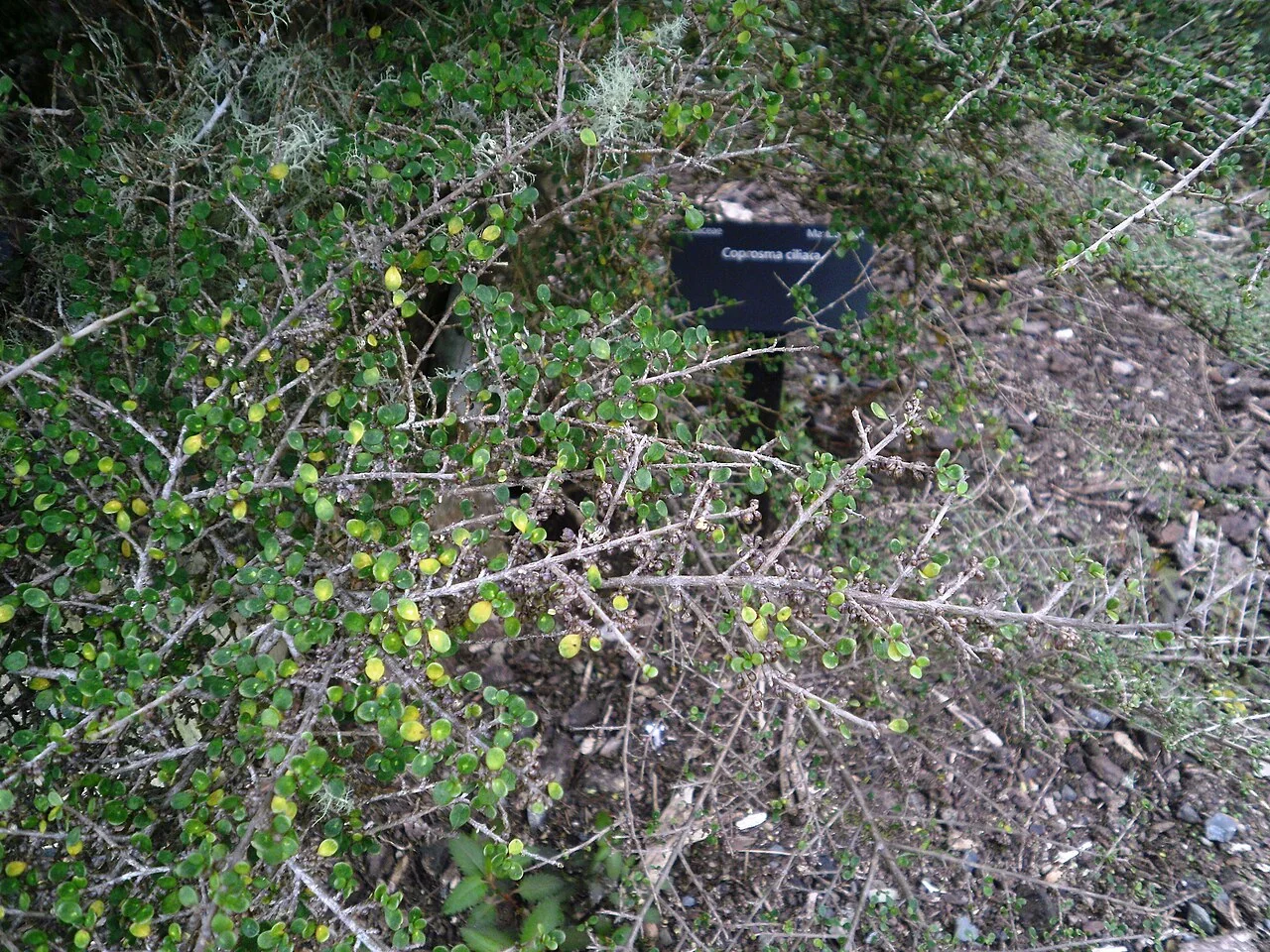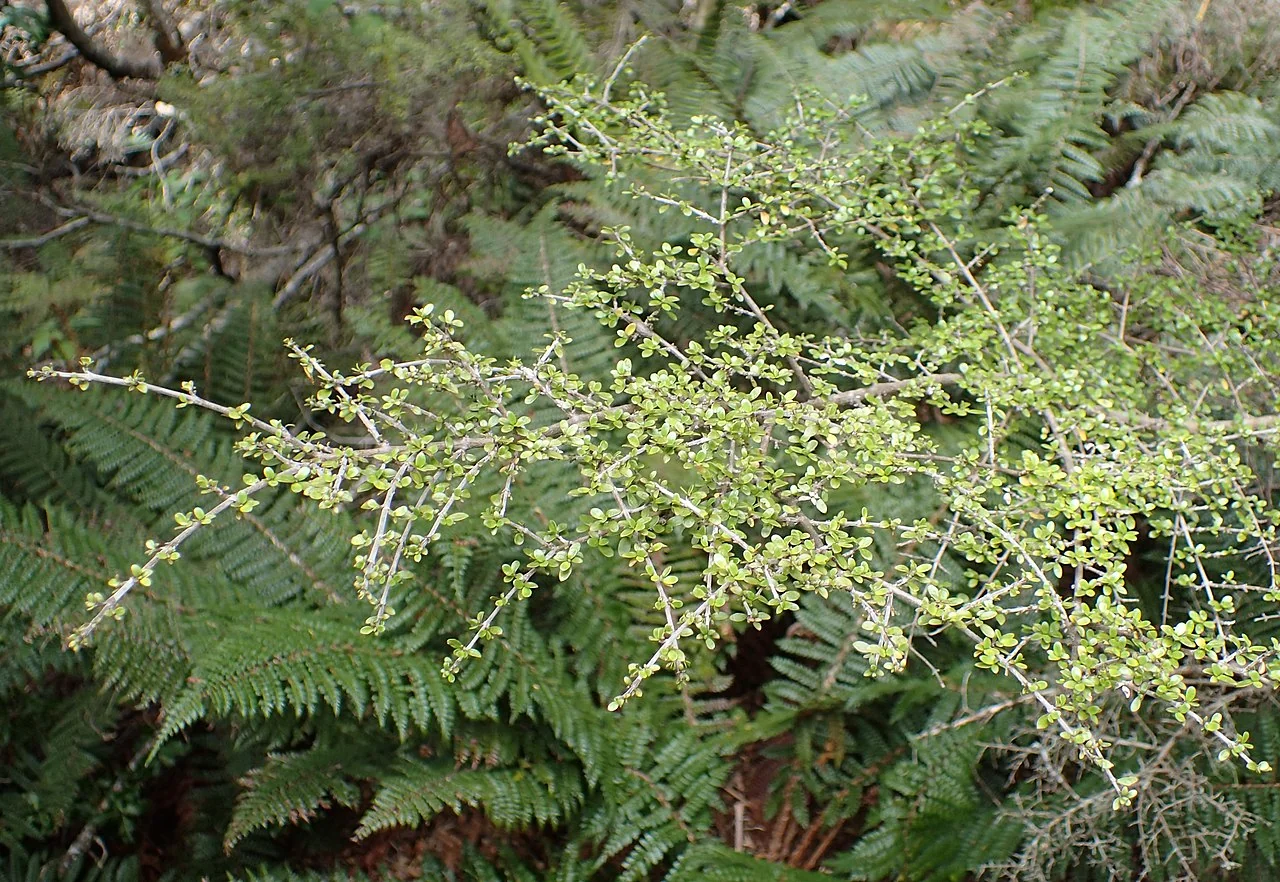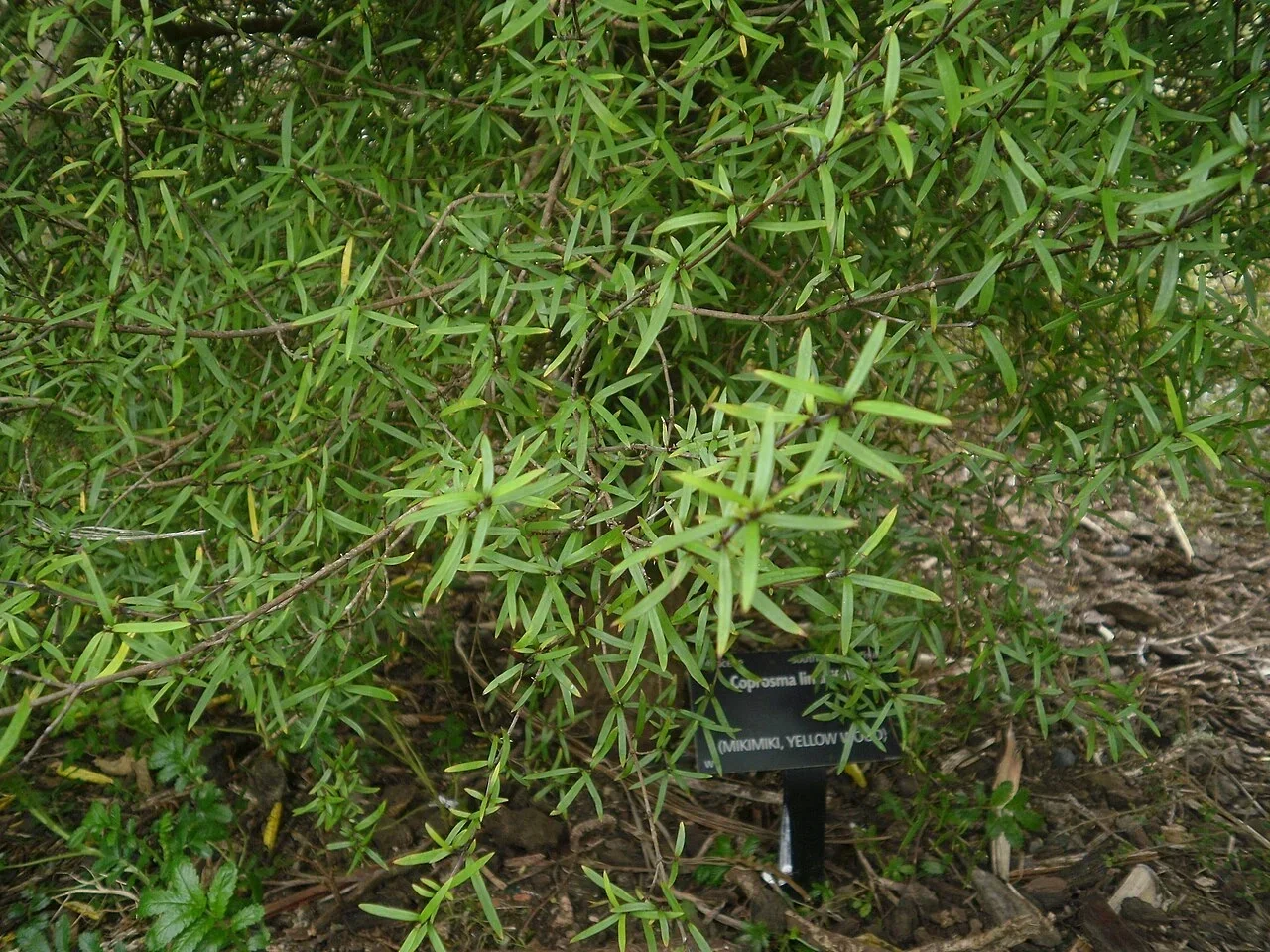
Mikimiki
Coprosma linariifolia
Coprosma linariifolia , also known as mikimiki or yellow wood, is a shrub among New Zealand's native shrubs or small tree native to New Zealand. It is found in lowland to montane forests and scrub throughout the North and South Islands. It is an erect, openly-branched tall shrub or small tree, capable of growing up to 8 meters (20 feet) tall. It has narrow, long elliptical leaves, typically up to 40mm long and 2-4mm wide, which are paler underneath and have small pits. The inner bark is yellow, which historically was used as a dye. The bark on the outside is grey. The flowers are small and green. It produces white berries, often flecked with blue. These fleshy drupes are dispersed by birds. It is hardy and can tolerate exposed sites, frost, and sandy soil. It thrives in full sun to part shade and prefers well-drained to moist conditions, showing high drought tolerance.

Plant Description
Botanical Features
Coprosma linariifolia , also known as Mikimiki or Yellow Wood, is a shrub or small tree native to New Zealand, growing up to 8 meters tall. It is characterized by its narrow, long elliptical leaves, typically up to 40mm long and 2-4mm wide, which are paler underneath and have small pits. The inner bark is yellow, which was historically used as a dye. The plant produces small green flowers and distinctive white berries, often flecked with blue, which are dispersed by birds. It is found in lowland to montane forests and scrub throughout the North and South Islands. This hardy species can tolerate exposed sites, frost, and sandy soil, thriving in full sun to part shade and preferring well-drained to moist conditions with high drought tolerance.
Quick Facts
| Scientific Name | Coprosma Linariifolia |
|---|---|
| Height | 1-3 m |
| Spread | 1-2 m |
| Water Needs | Low to moderate |
| Light | Full sun to part shade |
| Frost Tolerance | Good |
| Salt Tolerance | Excellent |
| Growth Rate | Moderate |
| Lifespan | Long |
Climate Best Suited to
White maire (Nestegis lanceolata) is primarily found in lowland to hilly forests across the North Island of New Zealand, extending to the Marlborough Sounds in the South Island. It demonstrates good adaptability to various conditions, thriving in areas with well-drained soils and tolerating both full sun and partial shade. Its natural distribution suggests a preference for warmer, more humid environments but with a reasonable tolerance for cooler temperatures found in its southern range.
Regional Suitability
| City | Climate Suitability |
|---|---|
| Whangārei | Ideal |
| Auckland | Ideal |
| Hamilton | Ideal |
| Tauranga | Ideal |
| Rotorua | Ideal |
| Gisborne | Ideal |
| New Plymouth | Ideal |
| Napier | Ideal |
| Whanganui | Ideal |
| Palmerston North | Ideal |
| Wellington | Ideal |
| Nelson | Ideal |
| Christchurch | Ideal |
| Dunedin | Moderate |
| Invercargill | Moderate |
Natural Habitat
Mikimiki ( Coprosma linariifolia ), also known as yellow wood, is a shrub or small tree native to New Zealand. It is found in lowland to montane forest and scrub throughout the North and South Islands, from the central North Island down to the bottom of the South Island.
Key Habitats Include:
- Forest and Scrubland: It is commonly found in lowland to montane forest and scrub, showcasing its adaptability to various forest and open shrubland environments.
- Widespread Distribution: Its widespread distribution across both the North and South Islands highlights its resilience and ability to thrive in diverse conditions.
Preferred Conditions:
- Full Sun to Part Shade: It can be found in both full sun and partial shade.
- Well-Drained to Moist Soil: It is tolerant of a wide range of soil types, from dry to moist, as long as they are well-draining.
- Tolerance: This hardy species can tolerate exposed sites, frost, and sandy soil, making it a versatile component of New Zealand's ecosystems.
The presence of Coprosma linariifolia in these diverse habitats underscores its ecological importance in contributing to the biodiversity and structural complexity of New Zealand's natural landscapes.
Plant Conservation
Mikimiki ( Coprosma linariifolia ) is currently classified as "Not Threatened" in its conservation status as of 2023. This status has been consistent in previous assessments, indicating a stable population in the wild.
Conservation Efforts:
- Widespread Distribution: Its widespread distribution across both the North and South Islands of New Zealand contributes to its stable conservation status.
- Adaptability: Its ability to thrive in diverse habitats, from lowland to montane forests and scrub, further supports its resilience.
- Ecological Importance: As a native species, it plays a role in supporting local ecosystems, providing food for birds through its berries.
While not currently threatened, ongoing monitoring and habitat preservation efforts are important to ensure the long-term health and stability of Mikimiki populations in New Zealand.
Growing Requirements
Soil Requirements
White maire (Nestegis lanceolata) is remarkably adaptable to different soil conditions, thriving in well-drained environments. It can tolerate a variety of soil types, from sandy to loamy, and prefers a neutral to slightly acidic pH. Good drainage is crucial to prevent root rot, ensuring healthy growth and development.
- Tolerates a wide range of soil types from clay to sandy
- Prefers well-draining soils but can handle occasional waterlogging
- Thrives in moderately fertile soils but will grow in poor soils too
- Can tolerate slightly acidic to slightly alkaline pH
- Handles coastal conditions including salt spray
Light Requirements
White maire (Nestegis lanceolata) thrives in a variety of light conditions, from full sun to partial shade. Optimal growth and flowering are typically achieved in locations receiving ample sunlight throughout the day. However, it can also tolerate some shade, especially in hotter climates, where it benefits from protection during the most intense afternoon sun.
- Full sun for optimal growth and form
- Can tolerate partial shade but may develop a leggier form
- At least 6 hours of direct sunlight daily is ideal
- Northern or eastern exposures work well in garden settings
Water Requirements
Once established, White maire (Nestegis lanceolata) is remarkably drought-tolerant, requiring minimal supplemental watering. During its establishment phase, consistent moisture is crucial to encourage strong root development. Mature plants can withstand dry periods, but regular watering during prolonged droughts will promote healthier growth and more abundant flowering.
- Moderate watering during establishment (first 1-2 years)
- Drought-tolerant once established
- Can handle periods of soil saturation
- Reduce watering in winter when growth slows
- Signs of overwatering include yellowing leaves and crown rot
Planting Guide
When to Plant
Mikimiki ( Coprosma linariifolia ) can be planted throughout the year, but the ideal time is often between May and June (late spring to early summer in the Southern Hemisphere), before the onset of intense summer heat. This allows the plant to establish its root system in moderate temperatures.
How to Plant
- Site Selection: Choose a location with full sun to partial shade. While it can tolerate full shade, colour intensity and growth may be optimized in brighter positions. Ensure the site has well-drained soil.
- Soil Preparation: Dig a planting hole that is twice as wide and to the same depth as the plant's root ball. Mix compost and other organic plant food into your existing soil to improve fertility and drainage. If planting in heavy clay soil, consider planting on a raised mound and adding gypsum to the bottom of the hole to improve drainage.
- Planting: Gently remove the plant from its container, tease out any circled or tangled roots, and position it in the hole so that the top of the root ball is level with the surrounding ground.
- Backfill and Water: Backfill the hole with the amended soil, gently firming it down. Create a raised ring of soil around the outer edge of the plant's root zone to help retain water. Water thoroughly immediately after planting to settle the soil around the roots.
Initial Care
- Watering: During the first growing season, ensure the plant receives regular, deep watering (once or twice a week) to help establish its root structure. Do not allow the soil to dry out completely during this period.
- Mulching: Apply a layer of organic mulch around the base of the plant to help retain soil moisture, regulate soil temperature, and suppress weeds.
By following these guidelines, you can ensure a successful establishment and healthy growth for your Mikimiki, allowing it to thrive and contribute to your native garden.
Ecological Role
Mikimiki ( Coprosma linariifolia ) plays several vital ecological roles in its native New Zealand environment, contributing significantly to the health and biodiversity of its ecosystems.
Key Ecological Contributions:
- Food Source: Its yellow fruit serves as a significant food source for native birds, and its green flowers provide sustenance for bees and other pollinators. The fleshy drupes produced by the plant are dispersed through frugivory, aiding in seed distribution and forest regeneration.
- Habitat and Shelter: As a tall shrub or small tree, growing up to 8 meters, it contributes to providing habitat and shelter for various organisms, including insects and birds.
- Ecosystem Adaptability: Its adaptability to diverse conditions, including sun, shade, wetland, and coastal environments, highlights its ability to thrive in different ecological niches and contribute to the resilience of these ecosystems.
- Riparian Plantings: It is particularly suited for riparian plantings, suggesting a role in stabilizing areas near water, preventing erosion, and improving water quality.
- Native and Endemic: Being native and endemic to New Zealand, it is an integral part of the local ecosystem, supporting the unique flora and fauna of the region.
The multifaceted ecological contributions of Coprosma linariifolia underscore its importance in maintaining the balance and health of New Zealand's natural landscapes.
Uses and Significance
Garden Uses
- Specimen tree for visual impact
- Suitable for native gardens and restoration projects
- Enhances native garden aesthetics and biodiversity
- Provides architectural accent with its unique structure
- Effective for erosion control on slopes and banks
Ecological Value
Ecologically, White maire (Nestegis lanceolata) plays a crucial role in supporting native ecosystems. Its fruits are a food source for birds, especially the kererū, contributing to the local biodiversity and food web.
- Provides a vital food source for native birds, especially the kererū
- Offers habitat and nesting sites for various fauna
- Contributes to soil stabilization and nutrient cycling
- Forms natural shelter belts, protecting other species
Landscaping Uses
Mikimiki ( Coprosma linariifolia ) is a versatile New Zealand native shrub or small tree with several valuable landscaping applications, prized for its attractive foliage, ecological benefits, and adaptability.
Key Landscaping Applications:
- Riparian Plantings: It is an excellent choice for planting near water bodies due to its tolerance for wetland environments, contributing to bank stabilization and ecological restoration.
- Wildlife Attraction: Its yellow fruit, often flecked with blue or black, provides a food source for native birds, and its flowers attract bees, making it suitable for bird and bee-friendly planting schemes.
- Hedging and Shelter: Mikimiki can be effectively used to create hedges, screens, and windbreaks, offering both aesthetic appeal and practical shelter in gardens.
- Revegetation Projects: Its hardiness and adaptability make it a suitable species for revegetation efforts, particularly in challenging environments.
- Coastal Gardens: This resilient plant thrives in coastal environments, tolerating sun, shade, wind, and salt spray, making it a valuable addition to seaside gardens.
- Mixed Plantings: Its unique yellow inner bark and flecked fruit add distinctive colour and texture, making it a standout in mixed garden beds.
With its evergreen nature and ability to grow up to 8 meters tall, Mikimiki offers year-round interest and structural presence in a variety of garden designs.
Seasonal Care Calendar
Spring
In spring, White maire (Nestegis lanceolata) begins its active growth phase. New foliage emerges, and it's an ideal time for planting new specimens or propagating. Ensure adequate moisture and monitor for early signs of pests.
- New growth begins with fresh foliage development
- Apply a balanced, slow-release fertilizer if desired
- Excellent time for planting new specimens or dividing offsets
- Monitor for new pest activity and address promptly
Summer
Summer is the peak growing season for White maire (Nestegis lanceolata), often accompanied by flowering. Consistent watering is important, especially for young plants, to support vigorous growth and prevent stress during dry periods.
- Flowering typically occurs in early to mid-summer (November-January)
- Water young trees regularly during extended dry periods
- Avoid heavy pruning during the active growing season
Autumn
During autumn, White maire (Nestegis lanceolata) prepares for the cooler months. Fruits or berries develop, providing food for native birds. It's also a good time for planting and general garden cleanup.
- Fruits or berries develop and ripen (December-February), attracting birds
- Natural leaf shedding occurs as part of its growth cycle
- Good time for planting new specimens to establish before winter
- Clean up fallen leaves if a tidy appearance is desired
Winter
Winter is generally a dormant period for White maire (Nestegis lanceolata). Minimal care is required, though young plants may benefit from protection in colder regions. This is an opportune time for any necessary structural pruning.
- Generally dormant with minimal growth activity
- No special winter protection needed in most mild climates
- Suitable time for structural pruning if required
- Fallen leaves can be left as mulch or removed for tidiness
When to Prune and How Much
White maire (Nestegis lanceolata) generally requires minimal pruning to maintain its natural form and health. Pruning should focus on removing dead or damaged growth and shaping the plant as needed.
- Remove dead, damaged, or diseased branches at any time of year
- Light formative pruning when young helps establish good structure
- To create a multi-trunked specimen, cut the main stem to encourage branching
- Fallen leaves can be removed for a tidier appearance, or left as natural mulch
- If necessary, lower branches can be removed to create clearance underneath
- Major pruning is best done in late winter to early spring before new growth
Always use clean, sharp tools for pruning to minimize the risk of disease and ensure clean cuts. The plant often responds well to pruning with vigorous new growth, contributing to a fuller, healthier appearance.
How to Grow Mikimiki
From Fresh White Berries
Fresh white berry propagation represents the most reliable and natural method for growing Mikimiki, taking advantage of this hardy species' excellent fruit production and natural dispersal strategy that has enabled it to establish across diverse New Zealand environments from coastal to montane elevations. This resilient endemic produces distinctive white berries heavily flecked with blue that provide exceptional opportunities for propagation while supporting the species' natural frugivory dispersal cycles essential for ecosystem function. The species' adaptation to both exposed coastal sites and inland montane forests makes it particularly valuable for restoration projects and challenging garden sites requiring drought-tolerant plants capable of handling salt exposure, frost, and sandy soils. Fresh berries yield significantly higher germination success compared to stored seeds, making immediate processing and sowing the preferred approach for both conservation propagation and garden cultivation of this ecologically important small-leaved coprosma. Collect ripe berries when fruits have achieved their characteristic white coloration heavily flecked with blue and can be easily removed from fuzzy dark twigs, timing collection to coincide with peak ripeness when seeds have reached maximum viability for successful establishment. Choose berries that are fully developed, firm, and show the distinctive white and blue coloration typical of mature fruit, avoiding any that appear damaged, diseased, or prematurely dropped which might indicate compromised seed quality. Process berries immediately after collection by macerating in water and thoroughly cleaning seeds, using gentle rubbing under running water to separate seeds from fruit pulp that could inhibit germination or promote fungal growth during establishment. Clean seeds by repeated washing until all fruit debris is removed, as the pulp can significantly inhibit germination if left in place, retaining the seeds that settle to the bottom while discarding floating material. Prepare optimal germination medium using free-draining seed-raising mix with excellent aeration properties, ensuring pH levels between 6.0-7.0 that support healthy development for this adaptable upland species. Sow fresh seeds immediately after processing, covering lightly with 2-3mm of fine sand to provide optimal conditions for germination while maintaining protection from drying out that can quickly kill developing embryos. Provide optimal environmental conditions including consistent temperatures between 15-22°C and bright light that supports germination while maintaining steady moisture without waterlogging throughout the extended germination period. Maintain careful moisture management throughout the 4-10 week germination period, as germination can be slow and irregular, requiring patience and consistent environmental conditions while monitoring for emergence signs. Keep propagation trays for extended periods to accommodate the variable germination timing characteristic of this species, ensuring optimal conditions are maintained throughout the potentially lengthy emergence window. Young seedlings develop at moderate rates while establishing the root systems necessary for adaptation to challenging growing conditions, requiring prompt transplanting into tubes of sandy, gritty mix when large enough to handle. Grow seedlings in high light conditions with modest feeding regimens that support healthy development without promoting excessive soft growth vulnerable to environmental stress during establishment. Harden off gradually before planting into well-drained soil in sun or part shade positions that replicate the natural exposed conditions where this species thrives while providing wildlife food resources.
From Semi-Hardwood Cuttings
Semi-hardwood cutting propagation offers a reliable vegetative method for growing Mikimiki that preserves the exact genetic characteristics of superior parent plants while providing consistent results for experienced propagators working with native plant cultivation and coastal restoration projects. This approach is particularly valuable for maintaining exceptional specimens that demonstrate superior salt tolerance, enhanced drought resistance, or other desirable traits that can be preserved through careful vegetative propagation techniques suited to this hardy coastal species. The method works well with Mikimiki because of this species' natural ability to develop adventitious roots under appropriate growing conditions, making it suitable for both commercial nursery production and specialized coastal restoration programs. Take 6-8cm semi-hardwood cuttings from healthy current-season shoots during late spring to early autumn when growth has achieved optimal maturity for rooting while retaining sufficient vigor for successful establishment under controlled propagation environments. Select healthy, vigorous shoots from the middle portions of branches that display the characteristic narrow linear leaves and robust growth typical of healthy Mikimiki development, avoiding both very soft growth and completely hardened wood that may resist rooting. Cut sections with clean, sharp secateurs, ensuring each cutting includes appropriate nodal development while selecting material that represents the best characteristics of the parent plant including compact growth habit and the distinctive linear foliage that characterizes this species. Remove lower leaves carefully to reduce transpiration stress while retaining sufficient photosynthetic capacity in upper leaves, taking care not to damage the narrow linear leaves that provide energy for root development during the establishment period. Lightly wound the base if stems are smooth to enhance root initiation, using gentle scraping techniques that expose cambium tissue without causing excessive damage to cutting material. Apply rooting hormone of low to moderate strength immediately after preparation, using formulations appropriate for semi-hardwood native species to enhance root initiation while ensuring even coverage of cut surfaces where new root systems will develop. Insert prepared cuttings into very free-draining medium such as 1:1 perlite and coarse sand, ensuring excellent drainage while maintaining the consistent moisture levels essential for successful root development without creating waterlogged conditions. Maintain optimal environmental conditions including bright light, high humidity without prolonged leaf wetness, and gentle bottom heat around 18-22°C if available, providing conditions that support root development while preventing cutting stress. Provide bright light that supports photosynthesis without causing excessive transpiration stress, replicating the full sun to partial shade conditions where this species naturally thrives in exposed coastal and montane environments. Keep growing medium just moist throughout the 4-8 week rooting period, maintaining consistent environmental conditions while watching for signs of successful root development including new shoot growth and resistance when gently tested. Root development occurs gradually as cuttings establish the fibrous root systems characteristic of mature Mikimiki plants adapted to challenging soils, requiring patience and consistent care throughout the establishment process. Pot successful cuttings into sandy, well-drained mix and harden off gradually before planting into permanent locations, providing growing environments that support transition from propagation to garden cultivation where they can contribute to native plant communities adapted to exposed conditions.
From Coastal Habitat Restoration
Coastal habitat restoration establishment provides a comprehensive approach to growing Mikimiki that focuses on recreating authentic coastal and montane ecosystems while contributing to landscape-scale conservation efforts and habitat enhancement for challenging environments. This method is particularly valuable for restoration projects that aim to reestablish diverse plant communities where this species plays important ecological roles as both wildlife food source through its distinctive blue-flecked white berries and structural component of coastal scrubland and montane forest edge communities. Mikimiki serves as an excellent pioneer species for challenging restoration sites, thriving in exposed conditions with salt exposure, frost, and sandy soils that challenge many other native species. Begin by identifying suitable restoration sites that provide the environmental conditions typical of this species' natural habitat, including areas with excellent drainage, exposure to coastal influences or montane conditions, and soil characteristics that support diverse native plant community development in challenging environments. Design restoration plantings that incorporate Mikimiki as part of authentic coastal scrubland or montane forest edge communities, combining it with appropriate companion species such as other salt-tolerant natives, hardy shrubs, and pioneer plants to create realistic ecosystem relationships that reflect natural plant associations. Source plant material through a combination of locally-adapted seedlings, fresh berry propagation, and cutting-grown specimens to ensure genetic diversity and adaptation to local environmental conditions that support long-term ecosystem establishment success in challenging coastal or montane sites. Prepare restoration sites by addressing drainage issues, managing salt exposure levels, and creating diverse microhabitat conditions that accommodate the varied requirements of coastal and montane plant communities adapted to challenging environmental conditions. Establish initial plantings during optimal seasonal windows in autumn or spring when environmental conditions support rapid establishment before plants face stress from summer heat, winter cold, or extreme coastal weather that can challenge even hardy native species. Space plantings according to natural coastal scrubland or montane forest edge development patterns, with appropriate density to encourage natural understory development while allowing room for plant growth and natural regeneration processes typical of pioneer ecosystem succession. Create diverse habitat structure by varying planting positions according to drainage gradients, salt exposure levels, and wind exposure conditions that replicate the natural environmental variation found in healthy coastal and montane ecosystems where this species naturally thrives. Integrate with complementary native species that historically occurred in coastal scrublands and montane forest edges, creating plant communities that provide enhanced wildlife habitat, erosion control on exposed slopes, and authentic ecosystem functions including soil stabilization and pioneer succession essential for challenging environment restoration. Monitor establishment success and provide appropriate maintenance including selective weed control, supplemental watering during establishment periods, and protection from extreme weather events that could damage developing coastal or montane plant communities during vulnerable early establishment phases. Allow natural ecological processes including seed dispersal by frugivorous birds, natural regeneration, and pioneer succession to enhance initial plantings, creating dynamic restoration sites that evolve over time while maintaining the essential ecological functions that Mikimiki provides in authentic New Zealand coastal and montane ecosystems. This approach requires sustained commitment and adaptive management compared to individual plant cultivation, but creates resilient and self-sustaining ecosystems that provide lasting environmental benefits including wildlife habitat, erosion control, and authentic landscape restoration that supports native biodiversity conservation in challenging environments.
Pests and Diseases
Mikimiki ( Coprosma linariifolia ) is generally considered a robust and healthy plant, but like all plants, it can be susceptible to certain pests and diseases, especially if growing conditions are not optimal.
Common Pests:
- Aphids, Mealybugs, and Spider Mites: These sap-feeding insects can occasionally infest Mikimiki, leading to weakened growth, leaf curling, yellowing, or the presence of sticky honeydew. Regular inspection and prompt treatment with natural pesticides like neem oil or insecticidal soaps, or simply a strong spray of water, can manage these pests.
Diseases:
- Fungal Issues: While specific diseases are not extensively detailed, poor air circulation or excessive moisture can sometimes lead to fungal problems like powdery mildew. Ensuring good air circulation around the plant helps prevent such issues.
- Natural Defense: Interestingly, the leaves of Coprosma linariifolia contain small hollows (domatia) that encourage certain types of mites. These mites feed on and help reduce parasitic fungi that might otherwise attack the leaves, acting as a natural biological control.
Prevention:
- Optimal Growing Conditions: Maintaining optimal growing conditions, including sufficient light exposure, well-drained soil, and adequate nutrients, will significantly enhance the plant's natural resistance to pests and diseases.
Overall, with proper care and attention to its environmental needs, Mikimiki remains a relatively trouble-free plant in the garden.
Cultural Significance
Traditional Uses and Values
Mikimiki ( Coprosma linariifolia ) holds cultural significance for Māori, who traditionally used its inner bark to produce a yellow dye. This dye was used for colouring flax fibers (harakeke) used in weaving cloaks and other traditional crafts. The plant's berries were also a food source for native birds, and its hardiness and widespread presence contributed to traditional ecological knowledge and resource management.
Bonus Tip
Expert Growing Advice
Mikimiki ( Coprosma linariifolia ) is an excellent choice for coastal gardens and exposed sites due to its high tolerance for salt spray, wind, and drought. Its fine-textured foliage and distinctive blue-flecked white berries provide year-long interest, and its hardiness makes it a valuable plant for erosion control and revegetation projects in challenging environments.
